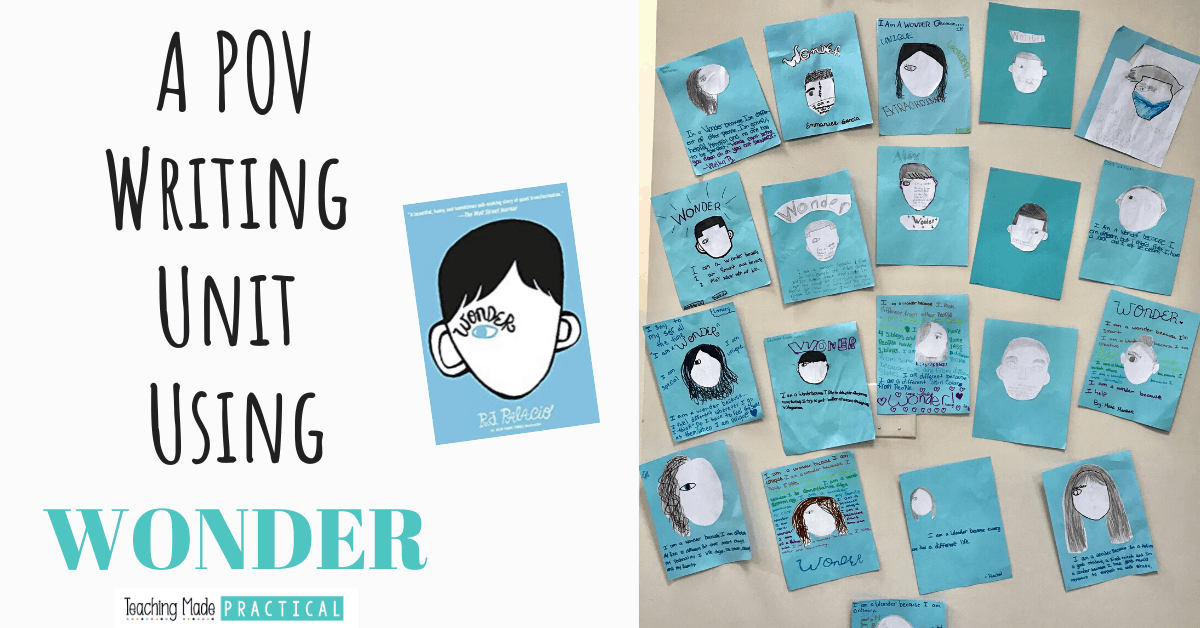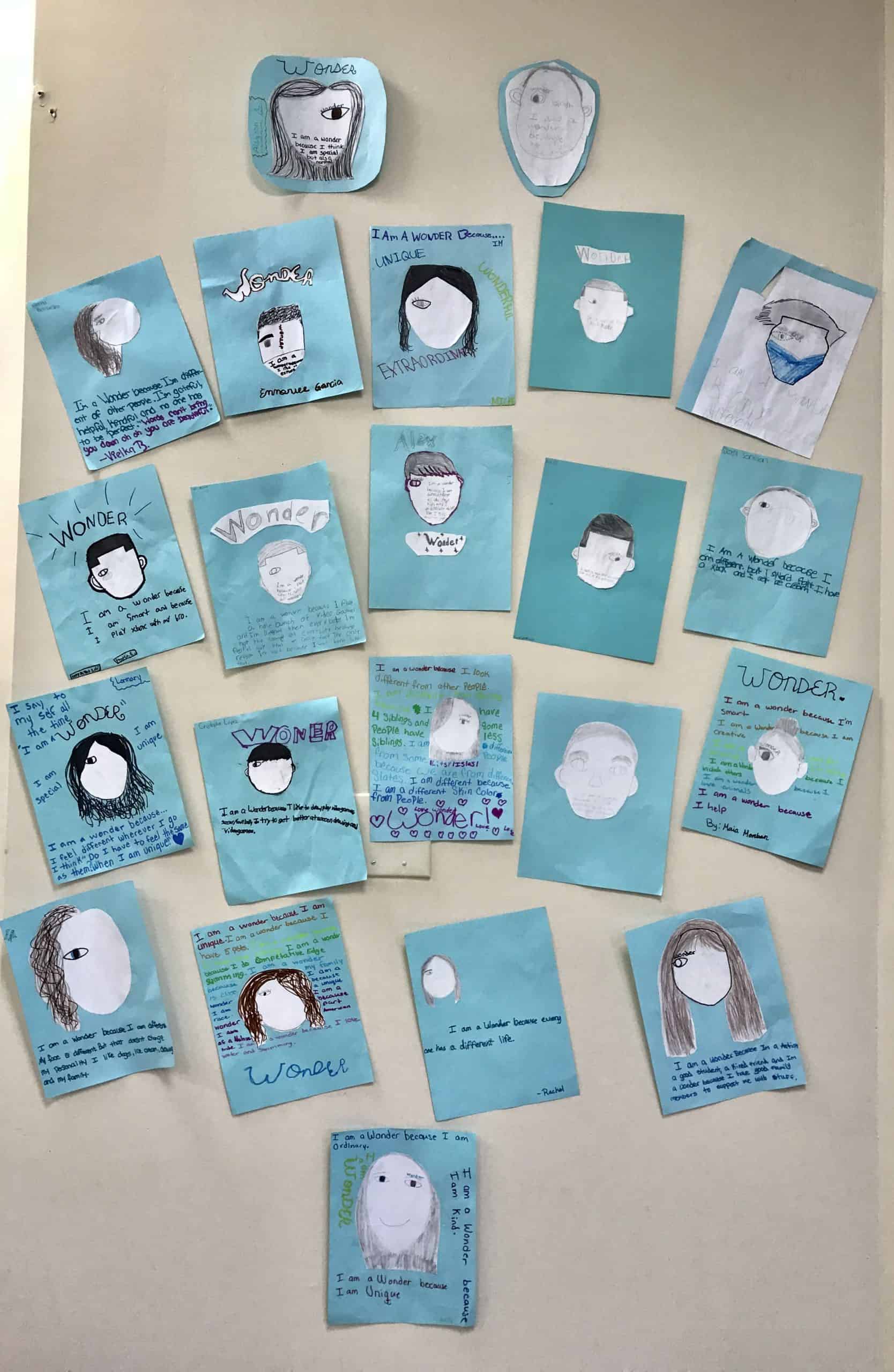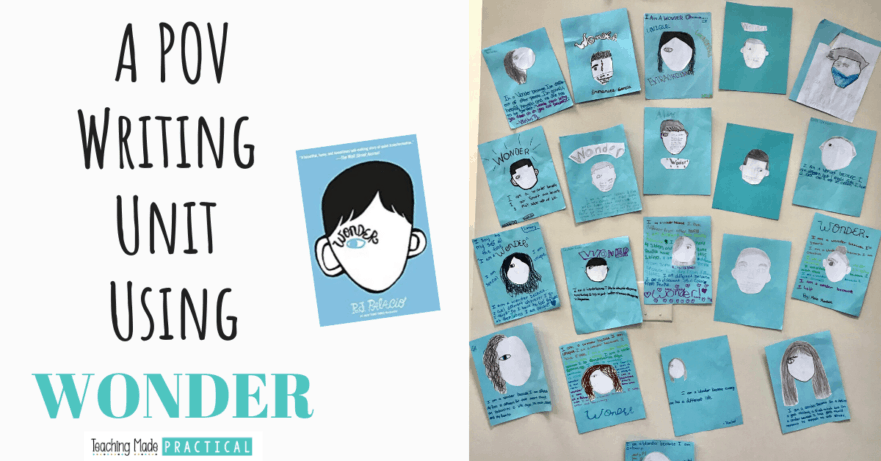
Written by guest blogger Daniela Garay
Are you looking for a fun and meaningful narrative writing unit for your 3rd, 4th, or 5th grade students? Here it is!
Language arts teachers strive for a stronger cross-curricular relationship between reading and writing that interconnects both subjects more purposefully and meaningfully. This point of view writing unit does just that!
It takes the ever-popular fifth grade read aloud, Wonder, and uses it as a framework for a creative perspective narrative writing unit. Students will be prompted to rewrite an event or chapter of the book from the point of view of a character that did not have a chapter with their perspective told.
Introducing the POV Writing Unit
After finishing reading Wonder, students will be introduced to the writing unit prompt and begin planning.
First, students will think of at least two possible character choices independently or in small groups. This should only take one writing class period, depending on how long your class periods are. When conferencing with students, encourage them to think beyond the main characters and even ones that aren’t human! I’ve had students write from the point of view of Daisy the dog, Mr. Tushman, and more.
You could prompt them with the following questions: Who do you wish you knew more about? Who is your favorite character that didn’t have a chapter? Who do you wish you knew their inner thoughts during a memorable moment?
Next, students will choose events or chapters where their character played a role, no matter how small, as long as they were present. For example, writing from Daisy’s point of view, a student wrote about her trip to the veterinarian. This step will take a few more writing class periods since it involves rereading parts of the book.
After conferencing, they will need to choose just one event or chapter to focus on for the next step which is all about their character. They will use a graphic organizer to plan their characters’ thoughts, feelings, and actions during the specific event or chapter. This will help students build dialogue for their character whether internal or external.
This will also be a great opportunity for a mini-lesson on vocabulary, emphasizing how to express feelings not only through strong adjectives but also through their characters’ actions or inactions. This step is crucial to students being able to convey their characters’ points of view!
The last step in planning will help make their drafts a lot more focused and organized. During this step, students will outline the sequence of their event or chapter using any variety of sequencing graphic organizers that best suits your students' needs. I usually use multiple depending on their specific levels and needs.
For example, for lower-level students, I may give a basic beginning, middle, and end organizer with transition words and sentence starters. For upper elementary students, I may give a blank outline with several boxes to break the event or chapter down even more.
A possible confusion to look out for amongst students is them writing the sequence of events of the whole book! Yes, this has happened in my classroom. Make sure to remind them that they are only focusing on their specific event or chapter.
You might also like these point of view graphic organizers.
Rough Draft, Editing, Revising the Point of View Paper
Inevitably, you will have multiple students working on the same characters, and maybe even the same events or chapters. Use this as an opportunity for focused heterogeneous small groups!
3rd, 4th, and 5th grade students can bounce ideas off each other, share books (if you are limited), ask each other questions specific to their character and/or event/chapter, peer edit, and revise. You will hopefully hear students having on-topic conversations and perhaps even save you from answering a bunch of questions...you’re welcome.
Students should draft using their sequence graphic organizers and character graphic organizers for reference. Additional mini-lessons during this time should be based on narrative writing such as dialogue rules, transition words, and how to write a conclusion.
For a rubric, I used a mandated narrative rubric from my school, so feel free to do the same. Just make sure they have reviewed it and have it handy during this time. (These free rubric makers and tips for using rubrics in the classroom might be helpful.)
Publishing the Final Drafts
For publishing, students are typically given an assignment via Google Classroom to publish using Google Docs. This allows students to practice their typing skills, use spellcheck, and allows you to comment on their work directly and even differentiate. For example, students can use voice typing on Google Docs.
However, you may choose to have students just write their final drafts on paper or publish using a different website, whatever works best for you and your students!

Extension and Reflection on Your Point of View Writing Project
Lastly, a fun extension activity I have done with students in the past has been them recreating the cover of the book. I always look for ways to integrate arts and crafts into the classroom because I seem to always have super talented artsy students.
For example, I’ve had students recreate the book cover using the same color scheme, but reflecting on what makes them a “wonder” and personalizing the face on the cover to fit their personality. However, you can use the same idea and have them create the cover for their character to go along with their published writing.
This writing unit helps reinforce students’ reading comprehension of Wonder, apply their knowledge of point of view, and helps them make the connection between reading and writing. Best of all, students are engaged and motivated during this unit because it is based on a book they know and love and it allows them to be creative and have choices.
You might also like some of these other writing tips and ideas for 3rd, 4th, and 5th grade classrooms.
Never Stress Over Sub Plans Again!

Make copies, find a fiction book, and you'll be ready for any emergency that comes your way!


